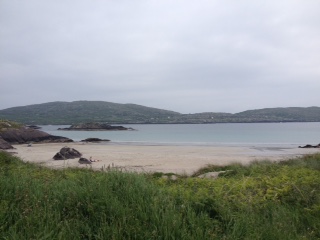 |
| Titanic Belfast Experience |
 |
| Flax seeds through to brown and bleached linen |
Growing flax and turning into linen cloth was a long and laborious process with many stages. Traditionally women and children prepared the flax and spun the fibres into thread at home on spinning wheels whilst men then wove the thread into linen cloth on hand looms.
 |
| Working from home Image from Titanic Belfast |
 |
| Flax Mill c.1840 Image: Titanic Belfast |
In the early 1840's linen cloth production moved from a home-based occupation in the country to a large scale factory-based one in the city. The different processes linen had to undergo before being made into cloth meant there were a series of hierarchical jobs within the mills accompanied by differing standards of working conditions and pay.
 |
| Mill production Image: Titanic Belfast |
 |
| Mill Production Image: Titanic Belfast |
 |
| Mill Production Image: Titanic Belfast |
Embroiderers were often lowly paid but their working conditions were healthier, and they were considered socially superior.
 |
| Examples of fine linen embroidery at the Ulster Museum |
The Titanic needed huge quantities of linen for her maiden voyage and these were all made in Belfast. The First Class passengers had damask linen tablecloths and napkins, patterned with the White Star emblem. Linens were also used for all the bedding as well as in the kitchens and dining room. The Titanic carried thousands of aprons and tablecloths and over 10,000 kitchen cloths, as well as 18,000 bed sheets and 45,000 table napkins! There were no facilities on board to wash anything, so there were separate stores for clean and dirty linens, and a drying room for wet linen so they did not become mouldy on the voyage.
The information above came from the Titanic Belfast Experience Museum. More information about the history of Irish linen can be found here
Walking around the Ulster Museum I came across an enormous hand-woven contemporary Irish linen artwork - The Game of Thrones Tapestry that opened at the museum in July 2017.
 |
| Game of Thrones Tapestry, Ulster Museum |
Now, I have not seen Game of Thrones, but I thoroughly enjoyed walking around this incredible tapestry which snaked back and forth across walls within the exhibition space. It is now 66 metres long, and consists of six 11m panels, one for each of the six series currently produced. By the time it is finished it will be longer than its inspiration, the Bayeux Tapestry which measures 77m. Here are some images of some of the series - are you a fan and can you recognise any of the scenes??
 |
| The Night is Dark and full of terrors.... |
 |
| Have you been paying attention...? |
 |
| Exquisite weaving and embroidery |
 |
| The End....for now...... |
Read more about this amazing tapestry and how it has reignited the awareness of Irish Linen and promoted Irish tourism here


































